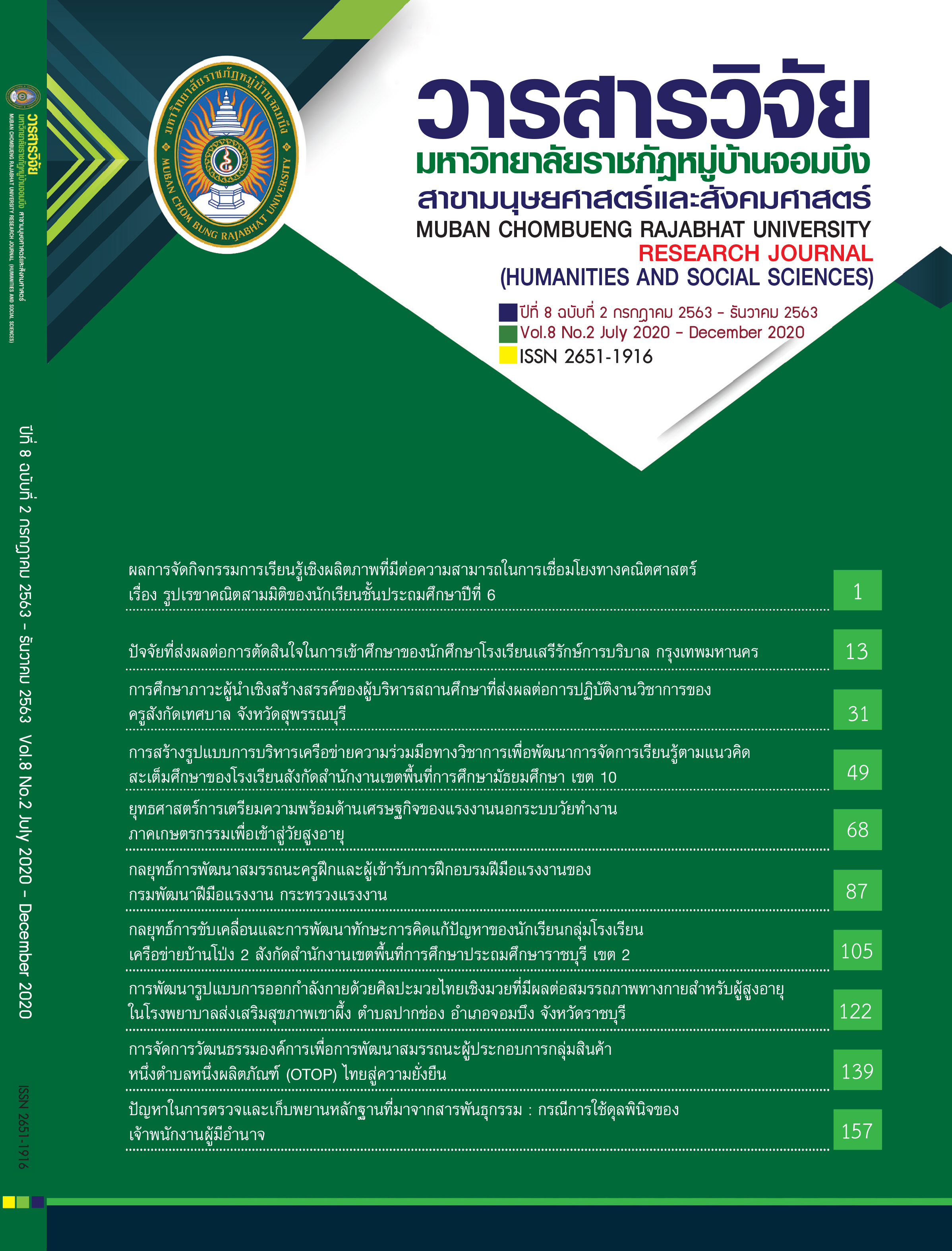Strategies to Drive and Develop Students’ Problem-Solving Skills of Ban Pong Network Schools Group 2 Under the Office of Ratchaburi Primary Educational Service Area 2
Keywords:
Strategies to Drive, Strategies to Develop, Problem-Solving SkillsAbstract
The purposes of this research were to study 1) strategies to drive the development of students’ problem-solving skills of Ban Pong Network Schools Group 2, 2) strategies to develop students’ problem-solving skills of Ban Pong Network Schools Group 2, and 3) results of the development of students’ problem-solving skills of Ban Pong Network Schools Group 2. The sample groups were 5 teachers teaching mathematics and science in Mathayomsuksa 1-3 (Grade 7-9) and 177 students studying in Mathayomsuksa 1-3 The research instruments were 1) a manual to carry out the strategies to drive and develop students’ problem-solving skills, 2) a test for teachers' knowledge and understanding on the development of students’ problem-solving skills, 3) a test to measure students' problem-solving skills before and after using strategies to develop students’ problem-solving skills, and 4) an interview form. The statistics for data analysis were the progress percentage, mean, and standard deviation.The research results were as follows: 1) The strategies to drive the development of students’ problem-solving skills consisted of Network Strategy, Participation Strategy, Empowerment Strategy, and Integration Strategy; 2) The strategy used by the network teachers to develop students' problem-solving skills was the STEM education learning management integrating with the problem-solving process under the framework of the manual to develop students’ problem-solving skill; and 3) the results of the development of students’ problem-solving skills revealed that before using development strategies, the mean was 12.02, and the standard deviation was 2.15, and after using the strategies, the mean was 24.64,the standard deviation was 2.23,
References
วัชรา เล่าเรียนดี. (2556). ศาสตร์การนิเทศการสอน และการโค้ช การพัฒนาวิชาชีพ : ทฤษฎีกลยุทธ์สู่การปฏิบัติ. (พิมพ์ครั้งที่ 12). นครปฐม: โรงพิมพ์มหาวิทยาลัยศิลปากร วิทยาเขตพระราชวังสนามจันทร์ นครปฐม.
สถาบันส่งเสริมการสอนวิทยาศาสตร์และเทคโนโลยี. (2561). “สะเต็มศึกษา” [STEM Education].กรุงเทพฯ: สถาบันส่งเสริมการสอนวิทยาศาสตร์และเทคโนโลยี.
สุวิทย์ มูลคํา. (2551). กลยุทธ์การสอนคิดแก้ปัญหา.กรุงเทพฯ: ภาพพิมพ์.
สำนักงานเขตพื้นที่การศึกษาประถมศึกษาราชบุรีเขต 2. (2562). ข้อมูลจำนวนครูและนักเรียนอำเภอบ้านโป่ง จังหวัดราชบุรี. ราชบุรี
สํานักงานเลขาธิการสภาการศึกษา. (2560 ). แนวทางการจัดการเรียนรู้ ที่เน้นผู้เรียนเป็นสําคัญ การจัดการเรียนรู้ แบบกระบวนการแก้ปัญหา. กรุงเทพฯ: ชุมนุมสหกรณ์การเกษตรแห่ง ประเทศไทย.
อนันต์ ม่วงอุมิงค์. (2560). กลยุทธ์การขับเคลื่อนการพัฒนาคุณลักษณะอันพึงประสงค์ของนักเรียนมุสลิมโรงเรียนพัฒนศาสน์วิทยาท่าแร้ง จังหวัดเพชรบุรี. วิทยานิพนธ์ครุศาสตร มหาบัณฑิต, มหาวิทยาลัยราชภัฏเพชรบุรี.
Scott, C. (2012). An Investigation of Science, Technology, Engineering and Mathematics (STEM) Focused High School in the U.S. Journal of STEM Education, 13(5): 30–39.
Shields, C. (2006). Engineering our future New Jersey elementary school. Retrieved October 14, 2017, from http://www.ciese.org/papers/2006/ASEE_paper_G.doc.
Downloads
Published
How to Cite
Issue
Section
License
Journal of TCI is Licensed under a Creative Commons Attribution-NonCommercial-NoDerivatives 4.0 International (CC BY-NC-ND 4.0) licence, unless otherwise stated, Please read our Policies page for more information on Open Access, copyright and permissions.



